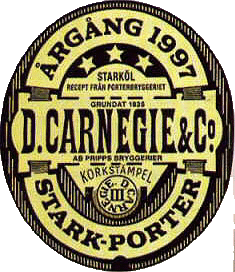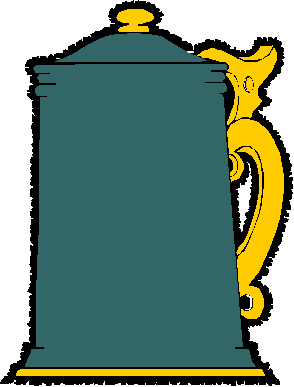Its time to set
things straight. A porter is not only somebody who carries your luggage for
you. No, in the beer world it is also a style, albeit a style named after
the guys who carried things for people many years ago. Porter is generally
an ale, though sometimes a lager, and sometimes is reminiscent of both.
Baltic porters are a very strong version, frequently bottom-fermented lagers
and often mimicking the Imperial stout style in flavor and alcohol strength.
In northern Europe, two porters stand out as being remarkable, world-class beers that should not be missed by any serious beer enthusiast. Finland’s Sinebrychoff Porter (often called Koff for short) and Sweden’s Carnegie Porter are both idiosyncratic, rich and delightful brews that are sure to take the chill off a frigid Nordic night.
Of the two, Koff Porter has always been my personal favorite, though Carnegie is no less a beer in its own right. Today, the beers are related in a sense, since both of the breweries which produce them are owned by Denmark’s giant Carlsberg brewing concern. Unfortunately for the beer world, Carlsberg has decided to terminate production of Carnegie Porter. The brewing business is much like Star Trek it seems these days, with the larger players running around like the Borg and assimilating the smaller breweries. Sadly, a lot of beer history is being lost along the way.
This is a move that is a great disappointment to brew gurus around the world. There should still be plenty of the 2001 maltage available, so I recommend that this is a beer you stock up on now if you possibly can. I bought several bottles at Sherlock’s in Marietta, Georgia this week, and will be adding to my stock.
Carnegie Porter is named for Scotsman David Carnegie, who owned a brewery in Sweden and first brewed the beer in 1836. In 1928, the brewery was acquired by the AB Pripps brewery, the largest brewer in Sweden until gobbled up by Carlsberg. The beer bears the same label it did when first introduced more than a century and a half ago. It advertises Carnegie Porter as Stark-Porter, or strong porter. The alcohol content is only 5.5% by volume, however, and the “strong” appellation has more to do with Swedish beer laws than a hefty percentage of alcohol.
 Carnegie Porter pours to a deep black color with a thick and creamy tan head
formation and a slightly toffeeish nose. There are strong suggestions of
chocolate, prune, and coffee present, set against a backdrop of lightly
roasty dark malt flavors. The beer finishes smooth with just a touch of
roasty bitterness.
Carnegie Porter pours to a deep black color with a thick and creamy tan head
formation and a slightly toffeeish nose. There are strong suggestions of
chocolate, prune, and coffee present, set against a backdrop of lightly
roasty dark malt flavors. The beer finishes smooth with just a touch of
roasty bitterness.
This is a classic beer that will age nicely. Pripps gives the beer a ten-year shelf life (my bottle says best before April 2010. I’m not sure I’d age this one that long, though I’m sure it would be quite nice at about five years or so. You can determine the maltage of a bottle of Carnegie by looking at the top of the label. The word “Argang” will be followed by the year it was brewed and bottled.
I will sorely miss this beer. Perhaps it will be revived by another brewery, as was the case with Samichlaus. Just in case it isn’t, however, I strongly urge you to pick some up. It could be your last chance to sample a world-class beer of legendary proportions.
In northern Europe, two porters stand out as being remarkable, world-class beers that should not be missed by any serious beer enthusiast. Finland’s Sinebrychoff Porter (often called Koff for short) and Sweden’s Carnegie Porter are both idiosyncratic, rich and delightful brews that are sure to take the chill off a frigid Nordic night.
Of the two, Koff Porter has always been my personal favorite, though Carnegie is no less a beer in its own right. Today, the beers are related in a sense, since both of the breweries which produce them are owned by Denmark’s giant Carlsberg brewing concern. Unfortunately for the beer world, Carlsberg has decided to terminate production of Carnegie Porter. The brewing business is much like Star Trek it seems these days, with the larger players running around like the Borg and assimilating the smaller breweries. Sadly, a lot of beer history is being lost along the way.
This is a move that is a great disappointment to brew gurus around the world. There should still be plenty of the 2001 maltage available, so I recommend that this is a beer you stock up on now if you possibly can. I bought several bottles at Sherlock’s in Marietta, Georgia this week, and will be adding to my stock.
Carnegie Porter is named for Scotsman David Carnegie, who owned a brewery in Sweden and first brewed the beer in 1836. In 1928, the brewery was acquired by the AB Pripps brewery, the largest brewer in Sweden until gobbled up by Carlsberg. The beer bears the same label it did when first introduced more than a century and a half ago. It advertises Carnegie Porter as Stark-Porter, or strong porter. The alcohol content is only 5.5% by volume, however, and the “strong” appellation has more to do with Swedish beer laws than a hefty percentage of alcohol.
 Carnegie Porter pours to a deep black color with a thick and creamy tan head
formation and a slightly toffeeish nose. There are strong suggestions of
chocolate, prune, and coffee present, set against a backdrop of lightly
roasty dark malt flavors. The beer finishes smooth with just a touch of
roasty bitterness.
Carnegie Porter pours to a deep black color with a thick and creamy tan head
formation and a slightly toffeeish nose. There are strong suggestions of
chocolate, prune, and coffee present, set against a backdrop of lightly
roasty dark malt flavors. The beer finishes smooth with just a touch of
roasty bitterness. This is a classic beer that will age nicely. Pripps gives the beer a ten-year shelf life (my bottle says best before April 2010. I’m not sure I’d age this one that long, though I’m sure it would be quite nice at about five years or so. You can determine the maltage of a bottle of Carnegie by looking at the top of the label. The word “Argang” will be followed by the year it was brewed and bottled.
I will sorely miss this beer. Perhaps it will be revived by another brewery, as was the case with Samichlaus. Just in case it isn’t, however, I strongly urge you to pick some up. It could be your last chance to sample a world-class beer of legendary proportions.
And remember, try a new beer today, and drink outside the box.
*Pricing data accurate at time of review or latest update. For reference only, based on actual price paid by reviewer.
(B)=Bottled
(D)=Draft

